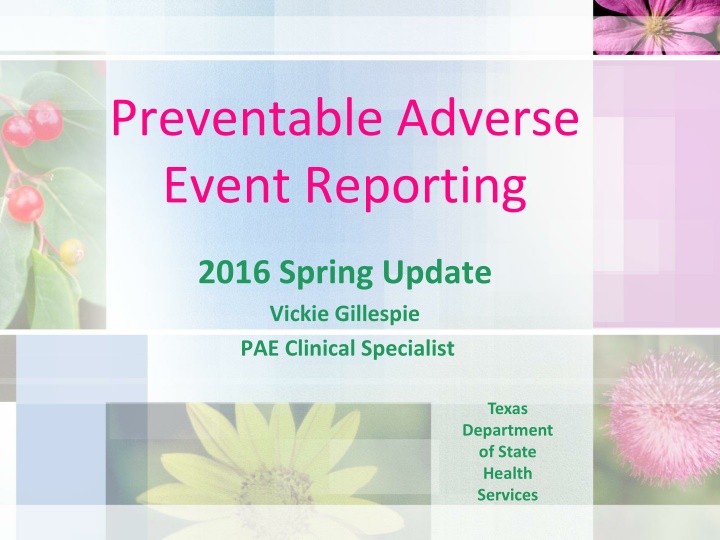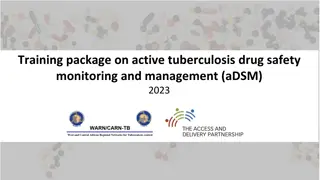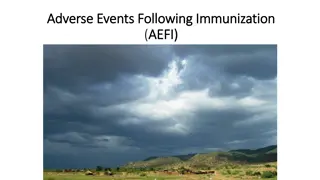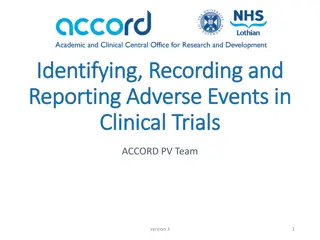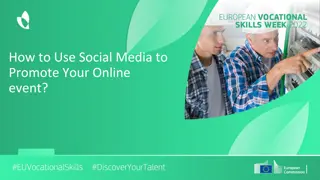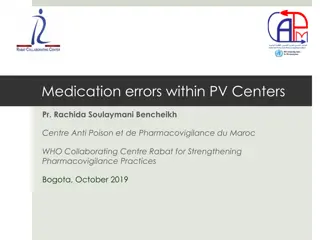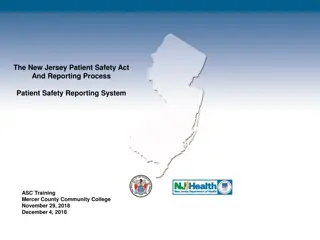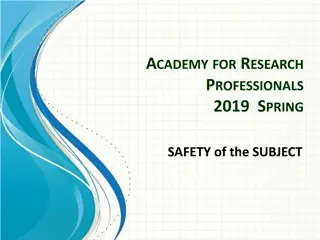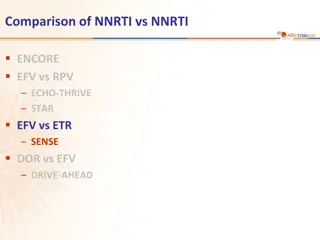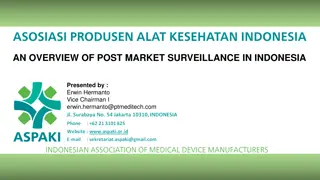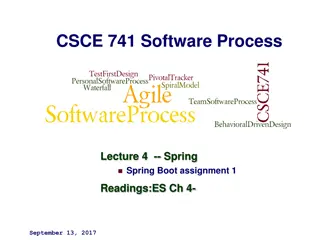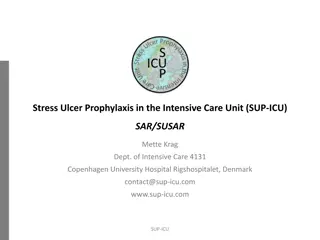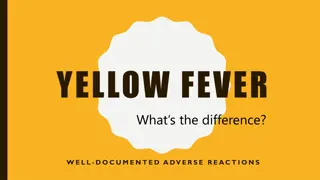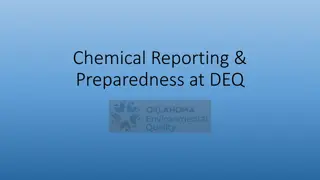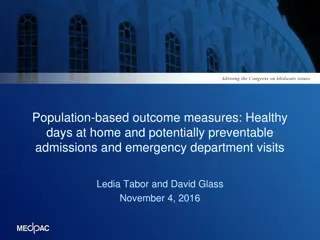Preventable Adverse Event Reporting 2016 Spring Update Summary
Annual Survey process, assessment of harm, reportable PAEs, differences between SREs and HACs, selected Tier 2 and 3 PAEs, 2015 PAE findings, case scenarios/FAQs, Report No. PAEs timeline, available resources on PAE website, upcoming training information, and contact details for questions and support. Facilities are required to complete the Annual Survey by June 30th for the previous calendar year, using either NHSN or TxHSN depending on HAI data submission.
Download Presentation

Please find below an Image/Link to download the presentation.
The content on the website is provided AS IS for your information and personal use only. It may not be sold, licensed, or shared on other websites without obtaining consent from the author.If you encounter any issues during the download, it is possible that the publisher has removed the file from their server.
You are allowed to download the files provided on this website for personal or commercial use, subject to the condition that they are used lawfully. All files are the property of their respective owners.
The content on the website is provided AS IS for your information and personal use only. It may not be sold, licensed, or shared on other websites without obtaining consent from the author.
E N D
Presentation Transcript
Preventable Adverse Event Reporting 2016 Spring Update Vickie Gillespie PAE Clinical Specialist Texas Department of State Health Services
Note Pages Please view the Notes Pages which are complete with narrative. Thank you!
Objectives 1. 2. 3. 4. 5. 6. 7. 8. 9. Review the Annual Survey process. Discuss assessment of harm. Review reportable PAEs. Describe the differences between SREs and HACs. Review selected Tier 2 and 3 PAEs. Share 2015 PAE findings. Discuss case scenarios/FAQs. Review Report No PAEs timeline. Review the resources that are available on the PAE website. 10. Inform participants of upcoming training. 11. Give contact information and answer questions. 3
Annual Survey The Annual Survey is required for all facilities. It will provide statistics to include on your Healthcare Safety Consumer and Technical Reports: Number of hospital beds (Hospitals) Number of patient days (Hospitals) Number of admissions (Hospitals) Number of procedures (ASCs) Information submitted is also used for the DSHS Annual Healthcare Safety Report. 4
Where is the Annual Survey? Facilities that submit HAI data to NHSN for Texas reporting will complete the annual survey in NHSN which is then exported to TxHSN with the HAI data. All other facilities will complete the annual survey in TxHSN. PAE users should complete the annual survey NO LATER than June 30th for the previous calendar year. 5
Where is the Annual Survey? To start, click on the Create Survey Icon on the TxHSN Main page. Enter SURVEY2016 for the name and choose the Facility Survey record type. Then Save. 6
Where is the Annual Survey? The Annual Facility Survey dashboard will now appear. Double Click on Data Collection or Click on View Question Package. 7
Annual Survey--ASC Complete all the questions. Enter 2015 as the *Survey Year and answers should be for 2015. Be sure to SAVE! 8
Annual Survey--Hospital Complete all the questions. Enter 2015 as the *Survey Year and answers should be for 2015. Be sure to SAVE! 9
Annual Survey Ignore Status in the Facility QPs Once you save, the Annual Facility Survey survey will be maintained in TxHSN. If you return to the question package, your answers should be there. 10
Annual Survey Your Annual Survey will now appear in your Recent Records Box. 11
NHSN Users Annual Survey Alert NHSN users will see this alert when they log into NHSN if they have not completed the annual survey.
IDRR in TxHSNNote Re: Survey For all users, HAI and PAE, if this sentence appears in your IDRR report, then you need to complete your survey in NHSN or in TxHSN as appropriate.
Assessment of Harm PAE s that start with the words Patient Death or Severe Harm are reportable if the assessed level of harm is Patient Death or Severe Harm. PAE s that do not start with those words, e.g. Foreign object retained after surgery, are all reportable regardless of the assessed level of residual harm. There are 3 choices for the level of harm question: Death Severe harm Other (includes Moderate harm, Mild harm, No harm, Unknown harm) 14
Severe Level of Harm Severe Level of Harm: Bodily or psychological injury (including pain or disfigurement) that interferes significantly with functional ability or quality of life. Severe Harm injuries requiring a major intervention e.g. Surgery Transfer to a higher level of care Bone fractures (may exclude minor fractures that do not require surgery or do not significantly interfere with functional ability or quality of life. 15
First Tier PAE Reporting--January 1, 2015 SURGICAL OR INVASIVE PROCEDURE EVENTS PATIENT PROTECTION EVENTS 1.Surgeries or invasive procedures involving a surgery on the wrong site, wrong patient, wrong procedure. 2.Foreign object retained after surgery. 3.Post-operative death of an ASA Class 1 Patient. 1. Discharge or release of a patient of any age, who is unable to make decisions, to someone other than an authorized person. 17
First Tier PAE Reporting--January 1, 2015 ENVIRONMENTAL EVENTS POTENTIAL CRIMINAL EVENTS 1. Any incident in which systems designated for oxygen or other gas to be delivered to a patient contains no gas, wrong gas, or are contaminated by toxic substances. 1. Abduction of a patient of any age. 2. Sexual abuse or assault of a patient within or on the grounds of a health care facility. 2. Patient death or severe harm associated with use of physical restraints or bedrails while being cared for in a health care facility. 3. Patient death or severe harm resulting from a physical assault that occurs within or on the grounds of a health care facility. 18
First Tier PAE Reporting--January 1, 2015 CARE MANAGEMENT EVENTS 1. Patient death or severe harm associated with unsafe administration of blood or blood products. 2. Patient death or severe harm associated with a fall in a health care facility resulting in a fracture, dislocation, intracranial injury, crushing injury, burn or other injury. 3. Patient death or severe harm resulting from the irretrievable loss of an irreplaceable biological specimen. 4. Perinatal death or severe harm (maternal or neonatal) associated with labor or delivery in a low-risk pregnancy while being cared for in a health care facility. 5. Patient death or severe harm resulting from failure to follow up or communicate laboratory, pathology or radiology test results. 19
Second Tier PAE Reporting--January 1, 2016 SURGICAL OR INVASIVE PROCEDURE EVENTS PATIENT PROTECTION EVENTS 1.Deep Vein Thrombosis (DVT) or Pulmonary Embolism (PE) after total knee replacement or after hip replacement. 2.Iatrogenic Pneumothorax with venous catheterization. 1. Patient suicide, attempted suicide or self-harm that results in severe harm, while being cared for in a health care facility. 2. Patient death or severe harm associated with patient elopement. 20
Second Tier PAE Reporting--January 1, 2016 ENVIRONMENTAL EVENTS 1.Patient death or severe harm associated with an electric shock while being cared for in a health care facility. 2.Patient death or severe harm associated with a burn incurred from any source while being cared for in a health care facility. POTENTIAL CRIMINAL EVENTS 1.Any instance of care ordered by or provided by someone impersonating a physician, nurse, pharmacist or other licensed health care provider. 21
Second Tier PAE Reporting--January 1, 2016 CARE MANAGEMENT EVENT RADIOLOGICAL EVENT 1.Any Stage III, Stage IV or Unstageable pressure ulcer acquired after admission/presentation to a health care facility. 1.Patient death or severe harm associated with the introduction of a metallic object into the MRI area. 22
Third Tier PAE Reporting--January 1, 2017 SURGICAL OR INVASIVE PROCEDURE EVENTS SURGICAL OR INVASIVE PROCEDURE EVENTS 1.Surgical site infections following spinal, shoulder, elbow procedure; laparoscopic gastric bypass, gastroenterostomy, laparoscopic gastric restrictive surgery or cardiac implantable electronic device. 1. Patient death or severe harm associated with an intravascular air embolism that occurs while being cared for in a health care facility 23
Third Tier PAE Reporting--January 1, 2017 PRODUCT OR DEVICE EVENTS PRODUCT OR DEVICE EVENTS 1.Patient death or severe harm associated with the use of contaminated drugs/devices or biologics provided by the health care facility. 1.Patient death or severe harm associated with the use or function of a device in patient care, in which the device is used or functions other than as intended. 24
Third Tier PAE Reporting--January 1, 2017 CARE MANAGEMENT EVENT CARE MANAGEMENT EVENT 1.Artificial insemination with the wrong donor sperm or wrong egg. 2.Patient death or severe harm associated with a medication error. Poor glycemic control: 1. hypoglycemic coma 2. diabetic ketoacidosis 3. nonketonic hyperosmolar coma 4. secondary diabetes with ketoacidosis 5. secondary diabetes with hyperosmolarity. 25
Chapter 98 Requirements Facilities shall report: An event included in the list of adverse events identified by the National Quality Forum (SREs) and A health care-associated adverse condition or event for which the Medicare program will not provide additional payment to the facility under a policy adopted by the federal Centers for Medicare and Medicaid Services (HACs). 26
Serious Reportable Events--SREs Serious Reportable Event (SREs) Never Events List of 29 events developed by the National Quality Forum (2002) https://www.qualityforum.org/Topics/SREs/Li st_of_SREs.aspx Most begin with Death or Severe Harm . Some SREs are also HACs. There is not a list of associated ICD-10 codes for the SREs. 27
Hosp Acquired Conditions--HACs Hospital Acquired Conditions (HACs) List of 14 Events/Event categories for which Medicare will not provide additional payment to the facility (2006) https://www.cms.gov/Medicare/Medicare- Fee-for-Service- Payment/HospitalAcqCond/icd10_hacs.html Condition not present on admission but is present on discharge 28
HACs Reported to NHSN for Texas Reporting CAUTIs in ICUs CLABSIs in ICUs/NICUs (VCAIs) SSI following CABG SSIs following CIED in Children s hospitals SSIs following spinal fusion in Children s hospitals 29
HACs Reported to TxHSN as PAEs Events that are only HACs are to be reported if they meet or would meet the HAC ICD-10 Codes-- DVT/PE after hip/knee surgery (2016) Iatrogenic Pneumothorax (2016) Poor Glycemic Control (2017) SSIs for certain events (2017)
HAC--SSIs to be Reported to TxHSN for PAE Reporting (2017) Certain spinal, shoulder, elbow procedures (exception spinal fusion in Children s Hospitals) Laparoscopic gastric bypass Gastroenterostomy Laparoscopic gastric restrictive surgery Cardiac Implantable Electronic Device (exception Children s Hospitals) 31
ICD-10 Codes for 755 Surgical Orthopedic HACs 0RQJXZZ Repair Right Shoulder Joint, External Approach 0RQK0ZZ Repair Left Shoulder Joint, Open Approach 0RGJ04Z Fusion of Right Shoulder Joint with Int Fix, Open Approach 0RGJ07Z Fusion of Right Shoulder Joint with Autol Sub, Open Approach 0RGJ0JZ Fusion of Right Shoulder Joint with Synth Sub, Open Approach 0RGJ0KZ Fusion of R Shoulder Jt with Nonaut Sub, Open Approach 0RGJ0ZZ Fusion of Right Shoulder Joint, Open Approach 0RGJ34Z Fusion of Right Shoulder Joint with Int Fix, Perc Approach 0RGJ37Z Fusion of Right Shoulder Joint with Autol Sub, Perc Approach AND K6811 Postprocedural retroperitoneal abscess T814XXA Infection following a procedure, initial encounter T8460XA Infect/inflm reaction due to int fix of unsp site, init T84610A Infect/inflm reaction due to int fix of right humerus, init T84611A Infect/inflm reaction due to int fix of left humerus, init
Pressure UlcersSRE and HAC HAC codes include Stage III and IV SRE includes Unstageable There are no ICD-10 codes for Unstageable (considered Stage III or IV) Unstageable Ulcers are to be reported as a PAE Stage III or Stage IV or Unstageable pressure ulcer acquired after admission/presentation to a health care facility.
PU Reporting Guidance On Admission and Documented Progresses to Reportable? Stage 3, 4 or Unstageable Skin intact Yes Stage 1 Stage 3 Yes Stage 1 Stage 4 Yes Stage 1 Unstageable Yes Stage 2 Stage 3 No Stage 2 Stage 4 Yes Stage 2 Unstageable Yes Stage 3 Stage 4 Yes
545 PAEs Reported in 2015 Total Number 207 Total Facilities Reported at least one PAE: 175 Hospitals 32 ASCs 503 PAEs 42 PAEs Type of Event Patient Death or Severe Harm Associated with a Fall 202 Resulting in a Fracture Foreign Object Retained After Surgery or Invasive Procedure 121 Wrong Site Surgery or Invasive Procedure 66 Patient Death or Severe Harm Associated with a Fall Resulting in an Intracranial Injury 43 Wrong Surgery/Procedure 29 Patient Death or Severe Harm Associated with a Fall 17 Resulting in Other Injury Perinatal Death or Severe Harm (maternal or neonate) Associated with Labor or Delivery in a Low-Risk Pregnancy while being cared for in a 17 health care facility Patient Death or Severe Harm Resulting from Failure to Follow Up or Communicate Laboratory, Pathology or Radiology Test Results 11 Sexual Abuse or Assault 8
521 PAEs Reported in 2015 Any Incident in which Systems for O2 or Other Gas Contains No Gas, Wrong Gas, or are Contaminated by Toxic Substances Type of Event Total Number 8 Surgery or Invasive Procedure on Wrong Patient 7 Patient Death or Severe Harm Associated with a Fall 6 Resulting in a Dislocation Patient Death or Severe Harm Resulting from a Physical Assault that Occurs within or on the Grounds of a Health Care Facility 3 Intra-operative or Immediately Post-operative Death of an ASA Class 1 Patient 2 Patient Death or Severe Harm Associated with Use of Physical Restraints or Bedrails 2 Patient Death or Severe Harm Associated with Unsafe Administration of Blood or Blood Products 1 Patient Death or Severe Harm Resulting from the Irretrievable Loss of an Irreplaceable Biological Specimen 1 Discharge or release of a patient of any age, who is unable to make decisions, to someone other than an authorized person 1 TOTAL 545
FAQPulmonary Embolism Q: A patient who was admitted to our facility after a fall with hip fracture. Patient cleared for surgery, with documentation that patient will not be a candidate for anticoagulant therapy (Pt is a high risk for bleeding). Patient underwent hip replacement without anticoagulant therapy and subsequently suffered a PE. Is this still reportable? A. Yes, this would still be reportable. Even though in this case it seems that the PE was not preventable, you still must follow the legislative mandate to report it. You do have an opportunity to document the circumstances of an event in the Specifics QP as well as make a comment on the public report.
FAQWrong Patient? Q: Would a vaginal exam utilizing a vaginal swab on a wrong patient be considered an PAE for invasive procedure? If not, is this reportable? A. No, this would not be reportable. A vaginal exam is not considered an invasive procedure. In the Definitions and Guidance Document (on the Resources page on the PAE website www.paetexas.org), a reference is made to the List of Invasive, High Risk or Non-Surgical Procedures, Institute of Clinical System Improvement. This reference appears the NQF Appendix B column for Wrong Procedure. This list states that a vaginal exam is not considered to be an Invasive, High Risk or Non-Surgical Procedure. The list is (Appendix A) in the Non OP Procedural Safety Fourth Edition Sept 12. Go to www.icsi.org and Search for it Or try this URL: https://www.icsi.org/_asset/1hht9h/NonOR.pdf
FAQPostpartum Hemorrhage Q. Would a PPH event (per JC SE Policy) meet the criteria for a Perinatal PAE? A: If a patient death or severe harm is associated with a postpartum hemorrhage and the event meets the remainder of the TxHSN criteria, then it would be a reportable Perinatal PAE. Determination of harm would be made by the facility s patient safety team. Our guidance does not include an amount of blood loss or units of blood given. For Texas, consideration for severe harm would certainly mirror Joint Commission s criteria of 4 units of RBCs, and further for Texas that determination could be made even with a lesser number of transfusions if other circumstances warrant it. In addition, the PAE for Perinatal events, includes the time frame within 42 days post-delivery while the JC event is the first 24 hrs postpartum.
FAQIatrogenic Pneumothorax Q: Regarding Iatrogenic Pneumothorax reporting, is this looking ONLY at a pneumothorax done while inserting a venous catheter? Would a nerve block procedure be excluded? A: Yes, this PAE is only with venous catheterization. A pneumothorax that occurs during a nerve block would be excluded. The associated ICD-10 codes for this PAE can be found in the notes section of this slide and you can see it is meant to be with venous catheterization.
FAQFailure to Communicate? Q: If lab results have been received by one physician but not communicated at change of shift, does this qualify as PAE? A: If the event described results in patient death or severe harm then yes it would qualify as a PAE to be reported. Transitions are problematic and that is why this is a Serious Reportable Event. Q: If a nurse has orders for STAT labs but does not collect until 3 hours post order, is this failure to follow up or a delay in care? A: This would be a delay in care and not reportable. Even though the delay in carrying out the order caused an untimely communication of results, a failure to fulfil orders was not the intent of the this PAE; rather, it has everything to do with failure to communicate or follow up results once obtained.
FAQElopement Q: What is the time frame for harm to occur after an elopement? A: At this time, we do not include a time frame in our guidance. If death or severe harm occurs associated with the elopement, no matter the time, it is reportable. Q: How would a facility find out if harm had occurred? A: A facility could find this out if 1) the facility finds the eloped person, or the person is brought back to the facility and harm is determined, 2) the medical practitioner tells the facility what happened to the patient, or 3) a credible third party tells the facility, such as law enforcement or a reliable family member. There may be other ways as well.
FAQElopement Q: How could we know that the harm is the result of the elopement? A. This would be a decision that the facility s patient safety team would make. The wording is associated with is included in the Definitions and Guidance document and reads Associated With means that it is reasonable to initially assume that the adverse event was due to the referenced course of care; further investigation and/or root cause analysis of the unplanned event may be needed to confirm or refute the presumed relationship. Therefore if it is reasonable to assume that patient death or severe harm that occurred was related to the elopement, then it would be reportable.
FAQForeign Object Retained? Q: If a foreign object (e.g. sponge) is found to be missing after the surgical wound has been closed, and the incision is reopened for removal prior to the patient leaving the OR, would this be a reportable PAE? A: Yes this would be reportable. For Texas, if the incision is closed and foreign object is still retained, it is a Foreign Object Retained . Please refer to the specifications, definitions and exclusions in the Definitions and Guidance Document. There is a Texas Note that says we are following Joint Commission Object Retained Sentinel Event guideline which states that a foreign object is considered retained if it is not intended to remain, and is incidentally found to be in any part of the patient s body after completion of the skin closure. Also please note that there are exclusions.
FAQForeign Object Retained? Q: A patient was receiving HH for wound vac dressing changes following an I/D of abcess. HH had changed wound vac dressing X 1. Patient then seen in OP and a 4X4 was found in the wound bed by the OP staff at the facility. Does this meet the PAE criteria? A: If Home Health did not use any 4X4s for their wound vac dressing change, and especially if it was a radiopaque 4X4, then it would have been left in the wound from the OR, so it would be reportable as a foreign object retained.
TxHSN Reporting Schedule Q1: Jan 1 Mar 31 H1: Jan 1 June 30 Q3: July 1 Sept 30 H2: July 1 Dec 31 Reporting Quarter Facility data submission deadline Within 60 days of end of reporting quarter DSHS takes preliminary data snapshot 1-Jun 1-Sept 1-Dec 1-Mar DSHS sends email to facility users review data ~15-Jun ~15-Sep ~15-Dec ~15-Mar Facility data corrections due Last day to verify no PAEs to report for half year 30-Jun 30-Sep 31-Dec 31-Mar DSHS takes final data snapshot 1-July 1-Oct 1-Jan 1-Apr DSHS sends email to facility to review data summary and make comments NA 15-Oct NA 15-Apr Facility comment period deadline NA 30-Oct NA 30-Apr DSHS reviews comments NA 15-Nov NA 15-May Public posting of data summary with NA 1-Dec NA 1-Jun 46 approved comments
Report No PAE Events Every facility must either: Report actual events that have occurred OR Confirm you have nothing to report for the Half year. Facilities who do NOT have any PAEs to report should confirm this in TxHSN for each half year time period. In mid June, Starting April 1, you can confirm No PAE events for H1 (Jan June). This must be completed no later than September 30th for H1. (June 30 is soft deadline) In mid December, Starting October 1, you can confirm No PAE events to report for H2 (July Dec). This must be completed no later than March 31st for H2. (Dec 31 is soft deadline) 47
Report No PAE Events Calendar Repeatable calendar for Reporting No PAE Events H1 H2 H1 Q2 Q3 Q4 Q1 April May June July Aug Sept Oct Report No PAE Events for H1 Nov Dec Report No PAE Events for H2 Jan Feb Mar
Report No PAE Events Calendar April 1--First Day you can Report for H1 Oct 1--First Day you can Report for H2 Mar 31--Last Day to Report for H2 Sept 30--Last Day to Report for H1 H1 Q2 H2 H1 Q1 Q3 Q4 April May June July Aug Sept Oct Report No PAE Events for H1 Nov Dec Report No PAE Events for H2 Jan Feb Mar
